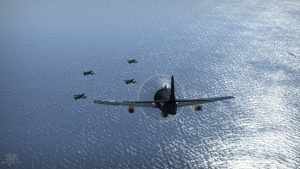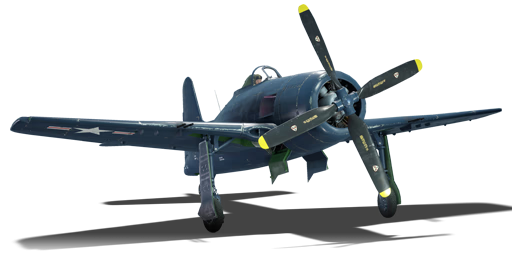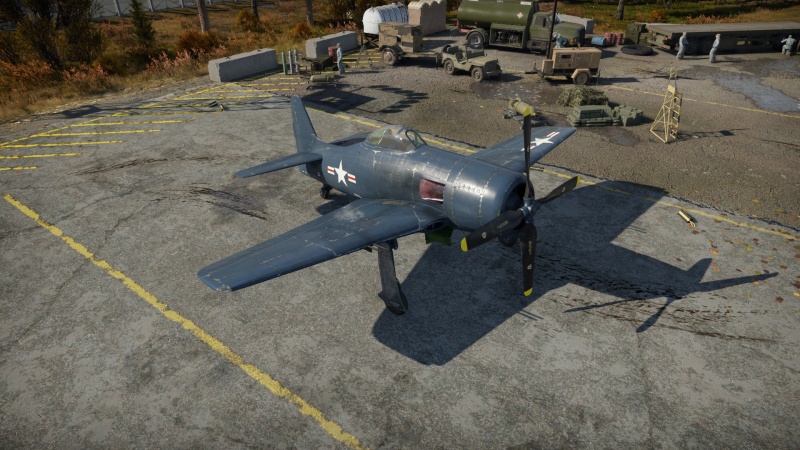F8F-1B
| This page is about the American naval fighter F8F-1B. For other versions, see F8F-1 and F8F-1B (France). |
Contents
Description
The F8F-1B Bearcat is a rank IV American naval fighter with a battle rating of 6.3 (AB/RB/SB). It was introduced in Update 1.33.
The F8F-1B is truly a worthy aircraft to end the single engine fighter line of the USN branch. Nimble, fast, and with great acceleration, it is sight of fear for the foe's eye! Most of its enemies will be jets and they will shiver as the Bearcat faces them with a 2 km altitude and (sometimes with) speed advantage! With WEP running (War Emergency Power, includes ADI(Water-Methanol Injection) for the big and hungry 2,300 horsepower Pratt & Whitney R-2800 Double Wasp) and modules maximized, the climb rate is well over 35 m/s. However, its main weakness is the Bearcat's very power source- the hot-running R-2800 Double Wasp.
General info
Flight performance
| Characteristics | Max Speed (km/h at 4,268 m) |
Max altitude (metres) |
Turn time (seconds) |
Rate of climb (metres/second) |
Take-off run (metres) | |||
|---|---|---|---|---|---|---|---|---|
| AB | RB | AB | RB | AB | RB | |||
| Stock | 672 | 647 | 10900 | 20.1 | 20.8 | 19.3 | 19.3 | 220 |
| Upgraded | 752 | 708 | 18.0 | 19.0 | 32.8 | 24.8 | ||
Details
| Features | ||||
|---|---|---|---|---|
| Combat flaps | Take-off flaps | Landing flaps | Air brakes | Arrestor gear |
| ✓ | ✓ | ✓ | X | ✓ |
| Limits | ||||||
|---|---|---|---|---|---|---|
| Wings (km/h) | Gear (km/h) | Flaps (km/h) | Max Static G | |||
| Combat | Take-off | Landing | + | - | ||
| 827 | 340 | 616 | 585 | 427 | ~10 | ~5 |
| Optimal velocities (km/h) | |||
|---|---|---|---|
| Ailerons | Rudder | Elevators | Radiator |
| < 465 | < 466 | < 600 | > 460 |
| Compressor (RB/SB) | ||
|---|---|---|
| Setting 1 | ||
| Optimal altitude | 100% Engine power | WEP Engine power |
| 995 m | 2,120 hp | 2,826 hp |
| Setting 2 | ||
| Optimal altitude | 100% Engine power | WEP Engine power |
| 5,090 m | 1,700 hp | 2,244 hp |
Survivability and armour
- 8.5 mm Steel - Under cowling engine armor plate
- 8.5 mm Steel - Fore cockpit protection plate
- 9.5 mm Steel - Pilots seat and headrest
- 60 mm Bulletproof glass - Windshield
Modifications and economy
The stock ammo belt for the M3 is great. So don't waste research here. Biggest problem early on is the sluggish behavior and gun jamming. The latter can be resolved with spending crew points in , which by now in Rank 4 should be already at a decent level. If you're trigger happy, there is bad news: New 20 mm cannons are a tier 4 upgrade. Instead focus on the engine upgrades. Especially Engine Injection which gives the plane a great boost of performance and turns it into a true bear. The New 20 mm cannons turn the weapons from a shotgun-like spread to significantly more accurate grouping. It is worthwhile to skip the 20 mm belt upgrade and focus on engine improvements until unlocking the New 20 mm cannons upgrade, as the default belts are nearly as devastating as stealth ammo, but with a tracer round added into the mix.
Armaments
Offensive armament
The F8F-1B is armed with:
- 4 x 20 mm AN/M3 cannon, wing-mounted (188 rpg outer + 225 rpg inner each wing = 826 total)
Suspended armament
The F8F-1B can be outfitted with the following ordnance:
- Without load
- 4 x 12.7 mm M2 Browning machine guns, wing-mounted (gunpods) (340 rpg = 1,360 total)
- 2 x Tiny Tim rockets
- 4 x HVAR rockets
- 1 x 1,000 lb AN-M65A1 bomb + 4 x HVAR rockets (1,000 lb total)
- 1 x 1,000 lb AN-M65A1 bomb (1,000 lb total)
- 1 x 1,000 lb AN-M65A1 bomb + 2 x 500 lb AN-M64A1 bombs (2,000 lb total)
- 3 x 1,000 lb AN-M65A1 bombs (3,000 lb total)
Usage in battles
In Arcade battles the F8F-1B can perform at its prime, which is, accordingly, remarkably. Due to the lack of damage due to overheating and such, the F8F-1B can easily outstrip any piston-engine fighter in a climb once upgraded.
Prior to the engine-injection upgrade, the 1B performs very well, but not as sublimely as it does with the latter modification. Thus, climbing and Boom & Zoom match perfectly with the F8F-1B in AB due to its astounding climb rate, speed, acceleration, and weaponry.
Regarding weaponry, fire in very short bursts with the M3 20 mm because they will jam rather quickly. The most ideal belt is Air Targets, as the belt has - together with the stealth belt, but the Air Targets belt has instead of a practice shell an API-T shell - the most HEF-I shells.

In RB, the F8F-1B is a monster. It possesses a fantastic climb rate, roll rate, high-capacity armament, and flight performance. Top speed and level speed are top notch, as is the dive-speed tolerance (~800 kph). Unfortunately, this power comes at a great price. Called the "Ovencat" by some players, the F8F-1B's engine could overheat in less than a minute while utilizing WEP.
It is not recommended for any pilot to use WEP until the "Radiator" modification is unlocked. Therefore, always side-climb at the beginning of a match as the 1B needs all the energy it can get, especially when facing opponents such as the Fw 190D which can out-climb a F8F-1B in continuous climb due to the lower thermal restraints of its Junkers engine.
The F8F-1B suffers at altitudes over 6,500 m. Below that utilize Boom & Zoom as the main tactic. Acceleration is magnificent as is dive speed. It will be difficult to rip the wings in a dive. Careful not to push the Bearcat too far, though, as rolling maneuvers and fast-paced moves can easily rip its wings.
The AN/M3 20 mm cannons have an extremely fast fire rate and thus may drain the ammunition storage rather quickly. However, the massive 826 round storage should be plenty for quite a lot of battling in the skies!
The F8F-1B can also be used as an effective fighter-bomber. It can carry a large payload of Tiny Tim's, bombs, and assorted rockets, making it an effective attacker.
Turning is not recommended in RB due to the 1B's mediocre turn rate.
Do not expect to out-climb every fighter in War Thunder. Expect to engage Fw 190D as the F8F-1B climbs. 109G-10, 109G-14, 109K-4, Tempest Mk.II, Spitfire Mk.XIVe, and J2M3 are able to reach the height of the 1B at the same time the 1B is able to.
The F8F-1B will often get matched with jets, however, and this is not a bad thing at all. Most jet pilots tend to overlook the piston-engine Bearcat and remain stuck in with jet-powered teammates - this is a window of opportunity. Gain some altitude and get ready to turn. Deploy flaps at will, since they don't blow off at any speed, and the F8F-1B can easily send a less aware enemy plummeting into the ground with the 20 mm cannons. If with a squad-mate in a jet - preferably something like the F-80 or the F-84, as the matchmaking is not so different - pretty amazing setups can be created, netting a good amounts of victories. One thing to worry about are Ho 229 V3, as their impressive turning capabilities may catch the player off guard.
Manual Engine Control
| MEC elements | ||||||
|---|---|---|---|---|---|---|
| Mixer | Pitch | Radiator | Supercharger | Turbocharger | ||
| Oil | Water | Type | ||||
| Controllable | Controllable Not auto controlled |
Controllable Not auto controlled |
Controllable Auto control available |
Separate | Controllable 2 gears |
Not controllable |
Pros and cons
Pros:
- Excellent dive speed
- Excellent manoeuvrability in moderate to high speeds
- Fast acceleration
- High rate of fire
- High ammo count
- Can support high G's in sharp turns and has a G-suit upgrade available
- Combat Flaps can't break, the wings will break faster
- Double the burst mass of the first F8F-1 Bearcat and in general powerful armament
- Great roll rate compared to planes such as the BF-109
- Respectable climb rate up to 5 km
- Excellent bomb capacity
Cons:
- Engine overheats quickly
- With the unbreakable combat flaps deployed, wings can rip in a high speed turn
- AN/M3 cannons jam in barely three seconds unless it's modified
- Not the fastest plane, so lots of planes can catch up
- Ground loops if landing with full brakes
- Sluggish controls at speeds less than 300 km/h
- Dumps velocity in high-G turns
- Rudder compresses to the point of uselessness over 600 km/h
History
The first idea for the creation of the Grumman F8F Bearcat was pitched after the Battle of Midway. Many pilots who took part in it remarked that one of the most important parts of naval air warfare was an aircraft's rate of climb. This of course meant that an increase in power was necessary. In 1943 the design work on the new aircraft began. The outline called for a fighter-interceptor, capable of operating even from small escort carriers. While the engine – the Pratt & Whitney R-2800 radial – was the same model used on the earlier F6F Hellcat, the new fighter would be lighter which also meant an increase in speed and climb rate. The concession was limiting the range of the new aircraft. The F8F would also feature a bubble canopy for better all around visibility. The first prototype, the XF8F-1, first took to the skies on the 21st August 1944. Further tests proved the aircraft's reliability and ruggedness, and the F8F was accepted into mass production. The first serial models rolled off the assembly line in February 1945 and were delivered to VF-19 fighter squadron, which began operating flights with the Bearcats in May 1945.
The new fighter, was, however, too late for any combat in World War II. After the war the situation of this propeller aircraft got even more complicated thanks to the introduction of naval jet aircraft. Even though the F8F was one of the fastest propeller-driven aircraft of its time, it was clear that the jet age was dawning. The F8F was replaced in US Navy and USMC service by the F9F Panther and the F2H Banshee jet aircraft. Some Bearcats saw combat service with the French in French Indochina in 1951, when they were used in the CAS role against the Viet Minh troops. Thailand also received a shipment of Bearcats which were then operated by the Thai Air Force. The F8F found a new life – thanks to its speed and acceleration - it was and still is widely used as a racing aircraft. One of the most famous racing Bearcats is the Rare Bear – a specially modified F8F, which holds many propeller aircraft speed and climb records.
Media
- Skins
- Videos
See also
Links to the articles on the War Thunder Wiki that you think will be useful for the reader, for example:
- reference to the series of the aircraft;
- links to approximate analogues of other nations and research trees.
External links
| Grumman Aircraft Engineering Corporation | |
|---|---|
| Aircraft | |
| Fighters | |
| F3F | F3F-2 · Galer's F3F-2 |
| F4F Wildcat | F4F-3 · F4F-4 |
| XF5F Skyrocket | XF5F · XP-50 |
| F6F Hellcat | F6F-5 · F6F-5N |
| F7F Tigercat | F7F-1 · F7F-3 |
| F8F Bearcat | F8F-1 · F8F-1B |
| Jet Fighters | |
| F9F Panther/Cougar | F9F-2 · F9F-5 · F9F-8 |
| F-11 Tiger | F11F-1 |
| F-14 Tomcat | F-14A Early · F-14B |
| Jet Strike Aircraft | |
| A-6 Intruder | A-6E TRAM |
| Bombers | TBF-1C |
| Export | ▄Martlet Mk IV · ▄F6F-5 · ▄F6F-5N · ▄F8F-1B · ▄Avenger Mk II · ▄Hellcat Mk II |
| ▄F-14A IRIAF | |
| Naval Vehicles | |
| Patrol Gunboat Hydrofoil (PGH) | USS Flagstaff |
| USA fighters | |
|---|---|
| P-26 Peashooter | P-26A-33 · P-26A-34 · P-26A-34 M2 · P-26B-35 |
| P-36 Hawk | P-36A · Rasmussen's P-36A · P-36C · ○P-36C · P-36G |
| P-39 Airacobra | P-400 · P-39N-0 · P-39Q-5 |
| P-40 | P-40C · P-40E-1 · P-40E-1 TD · P-40F-10 |
| P-43 Lancer | P-43A-1 |
| P-47 Thunderbolt | P-47D-22-RE · P-47D-25 · P-47D-28 · P-47M-1-RE · ⋠P-47M-1-RE · P-47N-15 |
| P-51 Mustang | P-51 · P-51A (Thunder League) · P-51C-10 · P-51D-5 · P-51D-10 · P-51D-20-NA · P-51D-30 · P-51H-5-NA |
| P-63 Kingcobra | P-63A-5 · P-63A-10 · P-63C-5 · ␠Kingcobra |
| Prototypes | XP-55 |
| F2A Buffalo | F2A-1 · Thach's F2A-1 · F2A-3 |
| BF2C | BF2C-1 |
| F3F | F3F-2 · Galer's F3F-2 |
| F4F Wildcat | F4F-3 · F4F-4 |
| F4U Corsair | F4U-1A · F4U-1A (USMC) · F4U-1D · F4U-1C · F4U-4 · F4U-4B · F4U-4B VMF-214 · F2G-1 |
| F6F Hellcat | F6F-5 · F6F-5N |
| F8F Bearcat | F8F-1 · F8F-1B |
| Other countries | ▃Ki-43-II · ▃Ki-61-Ib · ▃A6M2 · ▃Bf 109 F-4 · ▃Fw 190 A-8 · ▃Spitfire LF Mk IXc |





